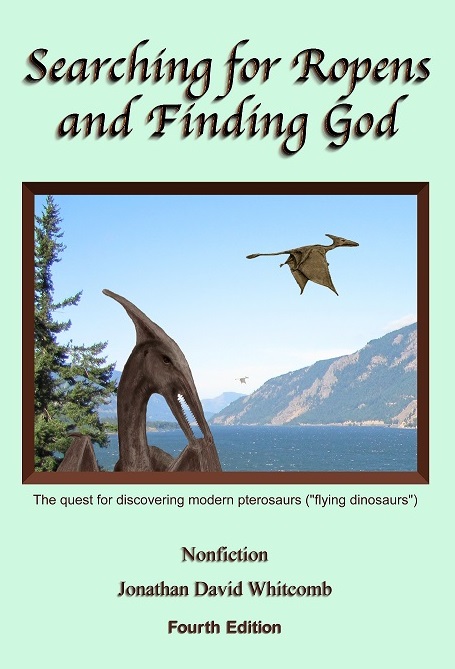At 360 pages in a 6-inch by 9-inch book—Searching for Ropens and Finding God may look heavy, but it’s sprinkled with humor and crafted for reading enjoyment. The fourth edition should be available on Amazon by about November 7, 2014. The following quotations are from the early part of this nonfiction book.
First part of the Title Page
This overshadows common true-life adventures, revealing the early stages of what may become the most unsettling scientific discovery since Galileo and Copernicus. It soars above disputes about religion, revealing why an official discovery of an extraordinary animal was delayed for so long. Above all, this explores human experiences—of eyewitnesses and those who interviewed them. People have become connected by common encounters: Persons of various faiths, with various levels of education, from various countries and cultures, have seen a living pterosaur.
From the Introduction
Expect references to the Biblical fiery flying serpent and the Flood of Noah. I added “finding God” to the title of the third edition to avoid offending anyone wanting only cryptozoology, a reader who would be offended to find a little religion, however limited; it’s continued in this fourth edition: finding God. Yet this is not mainly about religion, not in the usual sense. It’s less likely to take you to church than into the lives of ordinary persons who have encountered extraordinary flying creatures, and into the lives of Christians who have risked their health, even their lives, in searching for living pterosaurs. Our disbelief in the General Theory of Evolution has freed us to search far and near, and for years, with a firm belief that God’s purposes will prevail.
Beginning of Chapter 1
It looked like a dead pterodactyl; not fossil bones but with skin, like it had died recently. Could those creatures, non-extinct, still fly? Although I could not verify the photo was genuine, the idea within that image in a soon-forgotten book would be awakened four decades later, to plunge me into the most dramatic adventure of my life: exploring a remote tropical island, searching for giant living pterosaurs.
My first exposure to a remote tropical island with a giant reptile—when my younger sister Cindy and I were infants—came from Mommy reading Peter Pan. When I was four, the new sister was born, not to the name chosen by Cindy and me, “Captain Hook,” but to a name chosen by compromising parents: Wendy.
I came to regard the Peter Pan story a practical fiction, useful in more than just providing names for new babies. Each character had a role; the crocodile, however, at first puzzled me. In time, it resolved into both good and bad: useful to Peter Pan as true enemy to Hook but dangerous when out of place. Perhaps that was the seed of my understanding that a general principal can be complex, both true and false, useful sometimes but false when out of place, even dangerous.
From Chapter 3
“. . . in 1944 . . . I was stationed in Finschhafen, New Guinea, with the U.S. military. While there, I made several trips into some of the surrounding native villages with a friend of mine and a native guide (provided by the Australian government). On this one particular trip, we had the wonderful opportunity to witness a pterodactyl take off from the ground and then circle back overhead and to the side, giving us a perfect side view which clearly showed the long beak and appendage protruding from the back of its head . . . It was a big one! I have a Piper Tri-Pacer airplane [wingspan twenty nine feet] and it appeared to be about that size.
“The frequency of its wing flaps was . . . about one or two seconds. With each flap, we could hear a loud ‘swish, swish’ and the plants and brush immediately beneath its take off path were deflected by the down rush of air. I have not told many people about this as, of course, prehistoric creatures simply don’t exist!”
By telephone and letter, Hodgkinson told me more. Before spotting the creature, while the native guide was ahead of them on the trail, he and his friend stopped in a clearing. The two soldiers heard a “crashing” noise in the brush, and when they looked toward the uphill side of the clearing they saw the creature take off into the air. Before this takeoff, it was unseen. A wild pig, which had caused the noise, then ran to the downhill side of the clearing, into the taller brush; apparently, it had startled the “pterodactyl,” which then circled above the clearing. Hodgkinson didn’t remember much about the tail, for he was focusing on the head; after the creature had flown out of sight for the second time, however, the men did remember that they carried a military camera.
.

Searching for Ropens and Finding God, fourth edition, by Jonathan Whitcomb
###
“I have been reading some of your recent updates about ropens eating bats. That brought to mind a story I heard earlier this year by someone in my organization who served as a missionary in the Congo for some time. . . .”
Thank you to Eyewitnesses of Pterosaurs
. . . Eyewitness testimonies of natives, Australians, and the American veteran Duane Hodgkinson contributed, in the early years, priceless evidence. Reports from other areas of the world later supported our strange theory of modern living pterosaurs, including reported sightings in England, Spain, the Netherlands, various parts of Africa, Singapore, the Philippines, and other countries.
.



One Reply to “New Book on Ropens – Live Pterosaurs Worldwide”
Comments are closed.